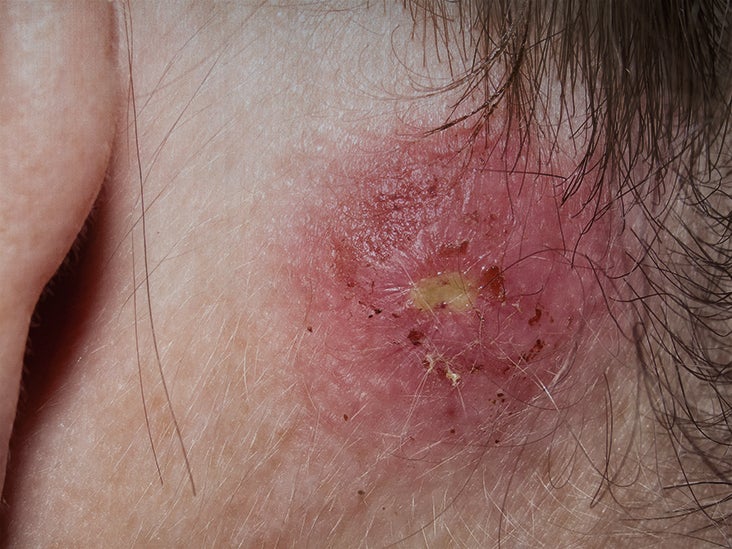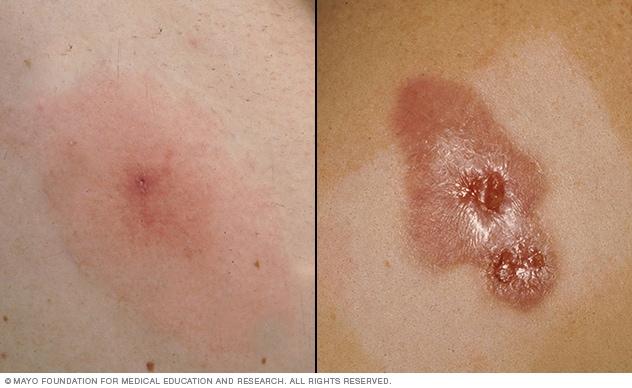If you think you might have a staph infection, it is important to be able to recognize the symptoms. Staph infections can range from mild to life-threatening, so it is always best to err on the side of caution and see a doctor if you are unsure. Symptoms of a staph infection can include: redness or swelling at the site of an injury or wound, pus or drainage from the site, fever, chills, or body aches.
If you have any of these symptoms, it is important to see a doctor right away so that you can get started on treatment.
- If you think you have a staph infection, see a doctor as soon as possible
- Early diagnosis and treatment is important to avoid serious complications
- There are several different types of staph infections, each with its own set of symptoms
- The most common symptom of a staph infection is a pus-filled blister or boil
- Other symptoms may include: -Cellulitis: This is a bacterial skin infection that causes redness, swelling, and pain
- It can occur anywhere on the body but is most commonly found on the legs or arms
- -Folliculitis: This is an infection of the hair follicles that causes red bumps around the hair shafts
- It is often itchy and uncomfortable
- -Impetigo: This highly contagious skin infection causes sores and crusting on the skin
- It is most commonly found in children but can occur in adults as well
Table of Contents
Ask a Doctor: Staph Infection
What Does the Start of a Staph Infection Feel Like?
A staph infection is a serious bacterial infection that can occur anywhere on the body. The most common symptom of a staph infection is a painful, red bump that can quickly turn into an abscess or pus-filled lesion. Other symptoms may include fever, chills, fatigue, and muscle aches.
If left untreated, a staph infection can spread throughout the body and cause life-threatening complications. Early diagnosis and treatment are essential to preventing serious health problems.
How Do I Know If I Caught a Staph Infection?
If you think you have a staph infection, it’s important to see a doctor right away. Staph infections can cause serious health problems if they’re not treated promptly.
There are several different types of staph infections, and each one has different symptoms.
The most common type of staph infection is cellulitis, which causes redness, swelling, and pain in the affected area. Other types of staph infections include impetigo, which causes sores on the skin; furuncles or carbuncles, which are deep-seated infections that often form abscesses; and MRSA (methicillin-resistant Staphylococcus aureus), a particularly dangerous type of infection that is resistant to many antibiotics.
If you have any of the following symptoms, it’s important to see a doctor right away:
-Redness, swelling, or pain in any area of your body
-Sores on your skin that are filled with pus or other drainage
-A fever over 101 degrees Fahrenheit (38.3 degrees Celsius)
When Do Staph Symptoms Start?
If you have a staph infection, you may not have any symptoms at all. But if your infection is more serious, you may have:
-A high fever
-Chills
-Sweating
-A general feeling of being unwell (malaise)
-Loss of appetite
-Muscle aches and pains
How Do You Rule Out a Staph Infection?
If you think you may have a staph infection, it is important to see a doctor right away. There are a few different ways to rule out a staph infection. First, your doctor will likely ask about your symptoms and medical history.
They will also do a physical examination. Based on this information, they may order some tests. These might include blood tests or cultures of the affected area.
If you have a skin infection, your doctor may take a sample of pus or fluid from the sore and send it off for testing. In some cases, imaging tests like x-rays or MRIs may be ordered. Once all the test results are back, your doctor can make a diagnosis and start you on treatment.

Credit: www.medicalnewstoday.com
Staph Infection Vagaina Symptoms
A staph infection of the vagina is a serious condition that can cause a variety of symptoms. The most common symptom is a burning sensation when urinating. Other symptoms can include:
– itching
– pain during intercourse
– unusual vaginal discharge
If you experience any of these symptoms, it’s important to see your doctor right away. A staph infection of the vagina is treated with antibiotics. If left untreated, it can lead to more serious health problems.
Pictures of Staph Infection
If you have ever had a skin infection, chances are it was caused by the Staphylococcus bacteria. This common bacteria is usually harmless, but it can cause serious infections if it gets into the body through a cut or scrape.
Staph infections can range from mild to life-threatening and can affect any part of the body.
The most common type of staph infection is cellulitis, which is a deep skin infection that causes redness, swelling, and pain. Other types of staph infections include impetigo, folliculitis, and MRSA (methicillin-resistant Staphylococcus aureus).
Most staph infections can be treated with antibiotics, but some (like MRSA) are resistant to standard treatments.
If you think you have a staph infection, it’s important to see a doctor right away so that you can get the proper treatment.
Staph Infection Stages Pictures
A staph infection is a serious bacterial infection that can occur anywhere on the body. The most common type of staph infection is called MRSA, which stands for methicillin-resistant Staphylococcus aureus. This type of staph infection is resistant to many antibiotics, making it difficult to treat.
How to Tell If a Staph Infection is Getting Better
If you have a staph infection, it’s important to monitor your symptoms and seek medical attention if they worsen. However, there are some signs that your infection may be getting better.
First, the area around the site of the infection may start to look healthier.
The skin may become less red and inflamed, and any pus or discharge should decrease.
Second, you may feel like your overall energy levels are improving. A staph infection can cause fatigue, so if you’re starting to feel more energetic, it’s a good sign that the infection is clearing up.
Third, your appetite may improve. A loss of appetite is common with a staph infection, so if you’re suddenly feeling hungry again, it’s a good sign that your body is healing.
Fourth, you may notice that your fever is gone or has significantly lowered.
Fever is often one of the first signs of a staph infection, so its disappearance can be an indicator that the infection is resolving itself.
Finally, any other symptoms you’ve been experiencing – such as muscle aches or headaches – should start to lessen in intensity or go away completely.
Symptoms of Staph Infection
A staph infection is a bacterial infection that can occur anywhere on the body. The most common symptom of a staph infection is a pus-filled sore or boil. Other symptoms include:
• Red, swollen skin
• Painful skin rash
• Blisters
• Abscesses (pus-filled pockets) under the skin
If left untreated, a staph infection can spread to other parts of the body and cause serious health problems. If you think you have a staph infection, see your doctor immediately for treatment.
Fastest Way to Cure Staph Infection
Staph infections are one of the most common types of infections, and they can be very serious if not treated promptly. The good news is that there are a number of effective treatments available for staph infections, and in most cases, they can be cured quickly. Here is a look at the fastest way to cure staph infection.
One of the most important things to do when you have a staph infection is to get it diagnosed quickly so that treatment can begin immediately. The best way to do this is to see your doctor as soon as possible. They will likely take a culture from the affected area to confirm the diagnosis and then prescribe antibiotics.
It is important to take all of the antibiotics prescribed, even if you start feeling better after a few days. This will help ensure that all of the bacteria are killed and prevent the infection from coming back.
In some cases, home remedies can also be effective in treating staph infections.
One popular home remedy is using tea tree oil, which has natural antibacterial properties. You can apply thisoil directly to the affected area several times per day or add itto a warm bath and soak in it for 20 minutes. Another option is taking garlic supplements, which also have natural antibacterial properties.
Garlic supplements can be found at most health food stores.
If you have a more severe staph infection, you may need to be hospitalized so that you can be treated with intravenous antibiotics. This is usually only necessary if the infection has spread throughout your body or if you have a compromised immune system.
Staph Infection on Skin
A staph infection is a bacterial infection that can occur anywhere on the skin. Staphylococcus aureus is the most common type of staph bacteria, and it can cause a range of problems from mild skin infections to life-threatening illnesses. Most staph infections are mild and can be treated at home with over-the-counter (OTC) medications.
However, some types of staph bacteria are more resistant to antibiotics and may require treatment with prescription drugs.
Staph infections usually start when the bacteria enter through a cut or scrape in the skin. The bacteria can also spread through contact with contaminated surfaces, such as towels, bedding, or doorknobs.
People who have chronic skin conditions like eczema or psoriasis are especially susceptible to developing staph infections. Symptoms of a staph infection include redness, swelling, pain, pus-filled bumps, or blisters. If left untreated, a staph infection can spread to other parts of the body and cause serious health complications.
If you think you have a staph infection, it’s important to see your doctor for proper diagnosis and treatment. In most cases, OTC medications are all that’s needed to clear up the infection. However, if your infection is more severe or doesn’t respond to OTC treatments, your doctor may prescribe oral antibiotics or topical creams/ointments containing antibiotics.
Staph Infection When to Go to Hospital
If you think you may have a staph infection, it is important to see a doctor right away. Staph infections can quickly become serious and even life-threatening. If you have any of the following symptoms, go to the hospital immediately:
• Fever of 101 degrees or higher
• Chills or sweats
• Red, hot, or swollen skin around the wound site
• Pus coming from the wound
Conclusion
If you have a staph infection, you may experience symptoms such as redness, swelling, pain, and pus-filled bumps. These symptoms can occur on the skin or in other parts of the body, such as the lungs or urinary tract. Staph infections are caused by bacteria that enter the body through cuts or other wounds.
If you think you may have a staph infection, it is important to see a doctor so that you can get treatment.
